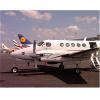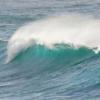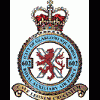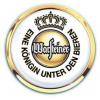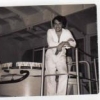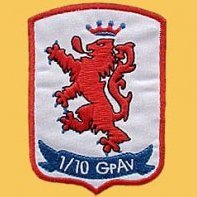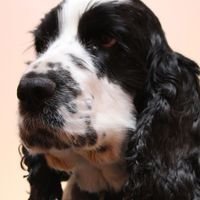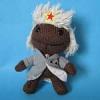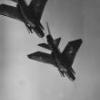Leaderboard
Popular Content
Showing content with the highest reputation on 31/03/19 in all areas
-
The Thud over Germany – F-105s of USAFE 1961 to 1967 The Story Anyone who has stood in front of a Thunderchief can only wonder how young pilots could master such a massive beast with a huge engine and small wings, but during May 1961 the first F-105Ds were flown direct from the USA to Bitburg in Germany, where they replaced the F-100 Super Sabres of the 36th TFW. They were brand new aircraft. The 49th TFW at Spangdahlem also received its new aircraft from October 1961 onwards. This was at the height of the Cold War and their principal role was nuclear strike, a mission known as ‘Victor Alert’ in the USAF. This was a big, complex aeroplane and brought with it big, complex maintenance problems. So much so that all aircraft were upgraded from 1962 onwards to a nominally common standard in a programme named ‘Project Look Alike’. This included many system upgrades but also required improved sealing between panels and a painted aluminium finish. An airfield arrestor hook was also fitted. Centralised maintenance was also introduced which meant an end to individual squadron markings. By the mid 1960s the Vietnam war was taking a significant toll on F-105s and during 1966 and 1967 the F-105s were transferred back to the USA as attrition replacements. By then there were enough F-4D Phantoms for the USAFE wings to re-equip. The colour schemes Aircraft were delivered in natural metal finish with glossy black radomes and matt olive drab upper fuselage. Those returned from the ‘Look Alike’ upgrades had the aluminium paint finish which replaced the natural metal. Finally the Vietnam type camouflage was applied during 1965, which also removed all squadron markings. Squadron markings were applied as follows: 36th TFW had three squadrons which were the 22nd, 23rd and 53rd TFS. Initially, during the natural metal period, each squadron displayed it’s colour on the fin in the form of 3 coloured stripes on a white diagonal background. The colours were 22TFS red, 23TFS blue and 53TFS yellow. After centralised maintenance was introduced all three colours were carried on the white diagonal on the fin. The 49th TFW squadrons were the 7th, 8th and 9th TFS. (7TFS blue, 8TFS yellow, 9TFS red). All aircraft carried a fin flash consisting of the wing badge and the three squadron stripes. Individual squadron colours were carried on undercarriage doors and sometimes on the nosewheel leg radar reflector. After centralised maintenance a three-coloured lightning flash was carried on the nose in addition to the fin marking. When camouflage was introduced, no wing or squadron ident was carried. The Models F-105D 60-0466 36th TFW / 22nd TFS, Bitburg, 1961 illustrating the early natural metal scheme. This is the fairly rare 1/72 Revell kit (looking very much like a down sized Monogram 1/48 kit). The kit represents a late Vietnam war F-105D and needed back dating. This meant removal of RHAW antennas, strike camera, wing strengthening plates, engine cooling scoops and gun cooling vents. The fin leading edge cooling intake needed enlarging and the aft part of the spine in front of this intake needed removing. Since the kit has raised line surface detail, this was all removed and re-scribed. This was all quite a lot of work but this is the best shaped F-105D so it was worth it. Finish was Alclad and AK metallics over Tamiya primer. Decals were mainly from Wolfpack. F-105F 63-8300 49th TFW / 9th TFS, Spangdahlem, 1963 illustrating the aluminium painted finish. This the Airfix kit with replacement canopy. The nose shape is too bulbous on this kit but it was the only 2 seater I had at the time! The Revell F-105G would make a better basis for this if you can face all the back dating and re-scribing! This also illustrates the red squadron colour on the undercarriage doors. F-105D 60-0511 49th TFW, Spangdahlem, 1965 illustrating the Vietnam camo finish. This is from the old Hasegawa kit. This was used as it represents the right configuration – i.e. it doesn’t have RHAW antennas, cooling scoops and vents, etc. The nose and canopy are not quite right on this kit and the undercarriage legs are about 1 cm too long – if you built it from the box you will have a Thunderchief standing on tip toes. The wing pylons have been replaced (kit pylons are far too small) and the drop tank fins were ridiculously thick and have been reworked. If I wanted another F-105D I wouldn’t go for this one! Maybe the Trumpeter kit would be better if you don’t mind all those rivets.30 points
-
Evening All, Moa has recently posted his Airfix Hannover HaWa F3 cabin conversion, which has lozenge camouflage on the wings. I noted that I had hand painted the lozenge on this Airfix Albatros which I put together more decades ago than I care to remember...... The model represents the D V of Lt von Hippel of Jasta 5 who was killed when he entered a steep dive and his wings fell off: a weakness of this aircraft which was caused by the sesquiplane wing structure. Under the high stress of a steep dive the lower wing spar twisted and failed with catastrophic consequences. The designers tried to rectify the problem by adding a small stiffner strut from the leading edge of the wing to the base of the V strut, but most pilots refused to go into a steep dive in persuit of an opponent. Lt von Hippel was an early victim of this problem. I have also painted the distinctive fuselage marking in red: some sources give it as black. There are also differences of opinion as to the shape of the arrow but as I had not seen any photos of the machine when i made this model, I used the only published source available to me. The lozenge markings were painted by hand, but I did not attempt the rib tapes as I did not have a suitable pen. I am also aware of the shortcomings of the Airfix kit, (one of thier earliest relaeses, from I think, 1958). In any event here is the model - about 45 years after I painted it..... Thanks for looking. P22 points
-
Good afternoon All. Not my finest hour, lots of faults and not brilliantly made. Airfix's A02010 Spitfiire MkI/MkII kit in 1/72 scale with Xtradecals 2008 Display Hawks decals, which include the 19 Squadron Spitfire to accomopany the 2008 19 Sqn 'SpitHawk' anniversary scheme. As an aside, a chap I used to work with had been part of the arms inspection team who used to host the Russians when they can to carry out arms treaty confirmation checks. Having spent time confirming with the 'guest' he was hosting that all the Hawks were merely trainers and all were unarmed, the hangar door was opened to reveal the camouflaged Hawk with 30mm gun pod and two underwing pylons. He said the guest just turned to him with the biggest grin he has ever seen! Anyway. The stencils are Airfix decals, the roundels, serials and '19's from the Xtradecals set; they are all the Xtradecals set includes. Eduard early RAF seatbelts and Yahu etch instrument panel help the cockpit, the landing light is a 2mm little lenses item and the early style pitot is scratch from some soldered copper wire. One more out of the stash and on to the shelf. I have just realised I haven't painted the wingtip nav lights; to be done later I think. Thank you for stopping by to look.22 points
-
Hi all, I thought you might like to see my 17th 1:32 scale build - the German Fokker D.VII fighter. This model is the ‘Wingnut Wings 1:32 scale model (Kit No: 32027) representing the Fokker D.VII (Albatros built) ‘Nickchen IV’, Serial No.817/18 operating with Jasta 53 during August 1918 and flown by Offizierstellvertreter Fritz Blumenthal. This model is displayed showing the Dutch designer Anthony Fokker posing and about to have his photograph taken. The basic list of modifications and additions to the model are as follows: Engine: Spark plugs. Cylinder fuel primers. Valve springs. Ignition lead support tubes. Ignition leads. Oil reservoir sight glass. Cylinder jacket coolant pipes. Cylinder separation. Hydraulic pipes. Intake manifold lock rings. Sump oil tube. Modified or corrected: ‘GasPatch’ Spandau machine guns. Gun installations. Cockpit control cable pulleys. Cockpit control lines. Cockpit cross bracing lines. Gun firing cables and hand throttle cable. Engine controls. Instrument leads/cables. Fuel pressure pump pipe. Wind baffle behind pilots head. Seat harness. Rigging points. Animation of control surfaces. External flight control lines. Rubber tyres on wheels. Photo-etch radiator. Aftermarket additions: ‘Proper Plane’ Heine 1:32 scale wood propeller (WP-003), ‘Taurus Models’ engine intake manifold lock rings (3211), ‘Taurus Models’ engine fuel priming cups (3219), ‘Taurus Models’ engine complete timing gear - conical valve springs (3209), ‘Gaspatch’ Spandau 08/15 extended loading handle (18-32128), ‘HGW Models’ Fokker D.VII seat belts (132302), ‘RB Productions’ Fokker D.VII radiators (RB-P32031), ‘Steve Robson’ supplied wheel rubber tyres, ‘Blackdog Models’ German photographer figure (F32008), ‘Aviattic’ Legend Series - Anthony Fokker figure (ATTL-02), ‘GasPatch’ Elite Accessories 1:48th turnbuckles (Type C), ‘Albion Alloy’ micro-tube 0.4 mm (NST04) and 0.5 mm (MBT05), ‘Steelon’ mono-filament (0.12 mm diameter), ‘Stroft’ mono-filament (0.08 mm diameter), ‘Aviattic’ linen effect decals - Fokker D.VII (Alb) 4 colour lozenge (ATT32164), (ATT32170) and (ATT32171). As usual I've created a downloadable build log in Adobe PDF format, for those who might want to refer to it for reference or build details. It contains full step by step descriptions of the model build, its modifications/changes and is also supported with illustrations and photographs. If viewed in Adobe Reader, each build log has book marked chapters/headings for easier navigation through the log. My model website has the gallery page, so to view any model, go to the gallery and select it. If it has a PDF build log, it will be available to download using the 'PDF' icon on that models photo's page. For any photograph, just click the photo to enlarge or reduce the viewing size. http://igavh2.xara.hosting My next model will be the ‘Aviattic’ stripped down (skeletal) model of the Fokker D.VII, which will be displayed alongside this Fokker D.VII model. The major airframe components are 3D printed and were purchased from the ‘Shapeways’ web site. All other components for the model will be ‘donated’ from the ‘Wingnut Wing’ kit of the Fokker D.VII (OAW built) (Kit No: 32030). Mike21 points
-
My recently completed 1/48 Hobbyboss Su-30, in Indonesian AF markings. Painted with Hataka Orange Line, and displayed on a Coastal Kits Display Base. Untitled by ian gaskell, on Flickr Untitled by ian gaskell, on Flickr Untitled by ian gaskell, on Flickr Untitled by ian gaskell, on Flickr Untitled by ian gaskell, on Flickr Untitled by ian gaskell, on Flickr Untitled by ian gaskell, on Flickr Untitled by ian gaskell, on Flickr Untitled by ian gaskell, on Flickr20 points
-
Thanks Ben Good idea Giorgio - see below Thanks Simon Thanks Rob It's sort of settled. Thanks Strickers and Andwil No tips for increasing the mojo but I use Paul Budzik's method - stick on the tape, burnish down and use a curved blade (#15 for me) pushed along the frame; you can see where you're going. For badly defined frames I use Bare Metal Foil (NMF) or painted Filmoplast book repair tape. HTH Thanks Bill I like the paste and don't forget you can airbrush it, thinned in white spirit, if you want a more even finish. Also thanks to Bill for putting me on to watercolour pencils. I used a black one to mark the demarcation and then a red liquidex pen on the rest: All done now: Just the nacelle windows and under fuselage lights to do. What colours are they, anyone know please?17 points
-
Here is another Airfix 1/72 A-4B Skyhawk finished as an aircraft from VMA-225 `Vagabonds'. The information came from Naval Fighters No.50 A-4A/B Skyhawk in USMC/USMCR/USNR service. The decals were made and printed by myself and the only other addition was the 150 gal fuel tanks which were from Freightdog Models. Robert14 points
-
Afternoon all. D.H.Lawrence's short story The Rocking-Horse Winner makes pretty much the same point Benedikt! Ta Giorgio! Yesterday was pretty much spent recovering from an excess of Peroni, Olive Marinati and Suprema di Pollo... Wouldn't say I was gluttonous for Italian food Giorgio but here's a selfie during the meal. 😀 That's an uncannily accurate representation of the life I lead Simon. In one of the other universes.... Please do some more Mr. P. I'm starting to get Gunbus withdrawl symptoms.... I trust that he has become less profligate with footwear as he's become older Keith. These things have to be nipped in the bud. https://www.aliexpress.com/item/Funny-Game-Inflatable-Water-Walking-On-Water-Shoes-Water-Game-Floating-Shoes/32806097547.html Kind of you Chris - thanks! A number of motley/fiddly tasks cleared from the snag list now. The saddle-seat and kneepad for the Air Gunner are now finished: In the end I ripped of the old Milliput version and added a saddle carved from scrap plastic as for some reason the usually reliable Milliput had refused to cure overnight. It's entirely possible that I got the mixing ratios wrong from tiredness as it's usually such a reliable medium. Halfway down the rear cockpit - in line with the Navigator's station - are a pair of large hexagonal windows, one on either side. These are hinged and have far morer prominent framing than the rest of the glazing, so in terms of 'visual weight', these really do require some proper attention. The shape itself is occasioned as you cansee below by the way they have to fit in between the two diagonal braces between the wing spars: These were then trimmed down to size and had some rear framing added for dimension, made out of some scrap brass rod that I'd hammered flat on the anvil: Fixed into place with epoxy: Given those elements now need time to cure, I moved away from the fuselage back to the scalloped cowling for the port engine, as this was not Airfix's finest hour when it comes to moulding: The inside of the cowling had to be thinned out with birr and sanding barrel to almost paper thin so that the engine can fit, so this was quite a tricky clean-up job. Some patient carving with a scapel from both direfctions though removed most of the seams, and the several holes in the poor moulding filled with Mr.Surfacer: There is a horizontal seam to scribe in where the top and borttom halves meet so I must remember to forget that at a later stage of the build.... A second exhaust ring also needed to be built: Reason being that if you have a squint at this lovely IWM photo of a Dutch squadron, you can clearly see the way the exhaust ring is visible from the rear quarter: As with the hexagonal windows, these are the kind of cumulative details that would in my eyes diminish the Anson 'character' by their absence, so have to be added: You can see just how transparent the hollowed-out cowling is in that shot so it's no suprise I managed to crack it a little when carving out the hole for the exhaust nozzle to poke through. A drip of TET has that sorted now. Finally; to pick up on previous discussion regarding braided cable for headphones - I think I've hit upon a decent way of representing thse in 1/72: This is a couple of strands of hair plaited together (being descended from a long line of Roscommon farming matriarchs. Mrs. B has long luxuriant tresses that do not lighten with age) that will I think keep me going for a few builds. The blessing of such material is that it comes pre-coloured and looks convincingly real under light! Take care of yourselves until next time. Tony14 points
-
This time the A-4M Sky Hawk model. Model from Trumpeter scale 1:32, made as always straight from the box. The model is easy to fold and fits on every shelf.13 points
-
Greetings to all, For a number of years, I`ve gazed upon the incredible works of art posted on this website. Now I`ve decided to “dip my toe” in the waters of Britmodeller. I`m beginning with the Airfix B-17G. I used AK Interactive Extreme paint and weathered the model by using a combination of paint, washes, and pastels. I found the kit to be excellent and enjoyed the entire process. Thank you in advance!!!! Mike PS : My apologies for my picture quality as my photography skills are very basic at best.13 points
-
Friends, After posting two WWII era aircraft, here is something more modern, the F-4G Wild Weasel version of the Phantom. I used the Hasegawa kit and posed in the early stage of Operation Desert Storm circa January, 1991. Early in the conflict, Phantoms toted four AGM-88 Harm missiles. This provided a bit of a difference for Phantoms usually carried 370 gallon external drop tanks on the outboard wing pylons. I added resin ejection seats and the AGM-88`s, AIM-7`s, and ECM pod came from the Hasegawa weapons set. Despite some “fiddly” challenges to this kit, I would recommend it to all. Thank you in advance!!!!!! Respectfully submitted, Mike13 points
-
Friends, Here is the Tamiya F4U-1 Corsair with the “birdcage” canopy. I used a combination of Mission Models, Model Master, and an old Polly Scale paints. I added the Aires resin “dropped flaps” for added realism. Like most Tamiya kits, it was a trouble-free build process. I used the kit supplied decals. Highly recommended. Thank you in advance!!!!! Respectfully submitted, Mike13 points
-
Hello friends, A small little tabletop that still makes me happy, when I finished it after a long time. Model is from eduard 1/48 scale. Cheers Andy12 points
-
Hi all This is my last finished project Eudard PP Bf 109E-3 1/48. I used resin parts Quickboost, gun barrels Master PL and masks with decals AML. The marking belongs to 3.J/88, pilot Hans Schmoller - Haldy. Thanks for looking Mirek12 points
-
Built from Airfix's venerable 1/32 kit, first issued when the car itself was new. best, M.11 points
-
So the second of the four Japanese aircraft I am putting together, Airfix's Mitsubishi Zero, built OOB with H Models Zero over Saipan decal set. The decals represent an aircraft, white 8-07 captured by the US Marines on Saipan Island in June 1944 and was transfered to the US for testing.This will be the second Airfix Zero I have built but the first was a normal kit where as this and no3 are both starter sets picked up from a well known supermarket and I get the feeling the starter sets quality is not as high as the normal kit (also had one of the Mustang starter from the same supermarket which had the wrong decals) I don't know if anyone has noticed this? The kit built fairly well but had flash on some of the smaller parts and the transparency moulding was not as defined as the previous Zero built, Used Tamiya acrylics through out. IMGA0761 by neil Connor, on Flickr IMGA0762 by neil Connor, on Flickr IMGA0763 by neil Connor, on Flickr IMGA0764 by neil Connor, on Flickr IMGA0765 by neil Connor, on Flickr And lastly lined up with its sister aircraft IMGA0766 by neil Connor, on Flickr10 points
-
Afternoon all, Here's some images from a great day on the fence at Fairford last week. I spent all day at the base, catching five of the deployed BUFFs depart mid morning and later returning in some of the best light you could wish for. Their arrival is arguably the most enjoyable half an hour I've had in this hobby In the order they were taken... Boeing B-52H Stratofortress 60-0032/LA US Air Force RAF Fairford 28/03/19 by Shaun Schofield, on Flickr Boeing B-52H Stratofortress 61-0013/LA US Air Force RAF Fairford 28/03/19 by Shaun Schofield, on Flickr Boeing B-52H Stratofortress 60-0024/LA US Air Force RAF Fairford 28/03/19 by Shaun Schofield, on Flickr Boeing B-52H Stratofortress 60-0025/LA US Air Force RAF Fairford 28/03/19 by Shaun Schofield, on Flickr Boeing B-52H Stratofortress 60-0058 US Air Force RAF Fairford 28/03/19 by Shaun Schofield, on Flickr Boeing B-52H Stratofortress 61-0013/LA US Air Force RAF Fairford 28/03/19 by Shaun Schofield, on Flickr Boeing B-52H Stratofortress 61-0015/LA US Air Force RAF Fairford 28/03/19 by Shaun Schofield, on Flickr Boeing B-52H Stratofortress 61-0013/LA US Air Force RAF Fairford 28/03/19 by Shaun Schofield, on Flickr Boeing B-52H Stratofortress 61-0013/LA US Air Force RAF Fairford 28/03/19 by Shaun Schofield, on Flickr Boeing B-52H Stratofortress 61-0013/LA US Air Force RAF Fairford 28/03/19 by Shaun Schofield, on Flickr Boeing B-52H Stratofortress 61-0013/LA US Air Force RAF Fairford 28/03/19 by Shaun Schofield, on Flickr Boeing B-52H Stratofortress 60-0025/LA US Air Force RAF Fairford 28/03/19 by Shaun Schofield, on Flickr Boeing B-52H Stratofortress 60-0025/LA US Air Force RAF Fairford 28/03/19 by Shaun Schofield, on Flickr Boeing B-52H Stratofortress 60-0025/LA US Air Force RAF Fairford 28/03/19 by Shaun Schofield, on Flickr Boeing B-52H Stratofortress 60-0024 US Air Force RAF Fairford 28/03/19 by Shaun Schofield, on Flickr Boeing B-52H Stratofortress 61-0015/LA US Air Force RAF Fairford 28/03/19 by Shaun Schofield, on Flickr Boeing B-52H Stratofortress 61-0015/LA US Air Force RAF Fairford 28/03/19 by Shaun Schofield, on Flickr Boeing B-52H Stratofortress 61-0015/LA US Air Force RAF Fairford 28/03/19 by Shaun Schofield, on Flickr Boeing B-52H Stratofortress 60-0058/LA US Air Force RAF Fairford 28/03/19 by Shaun Schofield, on Flickr Boeing B-52H Stratofortress 61-0015/LA US Air Force RAF Fairford 28/03/19 by Shaun Schofield, on Flickr Thanks for looking, comments welcomed Shaun9 points
-
Hi Everyone, having just started my group build M247 Sgt York, I thought I would post my recent Tamiya build. I was spoilt for choice for the group build and this M60A1 was an option. It is such a cool looking vehicle I couldn't resist and so went ahead and did an OOB build. The main goal was to practice some techniques for painting the MERDC camo. I have read differing views on whether these vehicles ever appeared in the desert retaining their MERDC colour scheme, so I have gone with a bit of artistic licence and I think the multi colour scheme works well on this vehicles with the additional armour plates. I'm pretty happy with how it came out, I have chosen the less is more approach to the weathering and am only a bit disappointed with the decals not quite sitting as I wanted. I think they could be redone but other kits are now in progress so I will leave as is for the time being. The figure is from the spares box and although I failed at getting the skin and face right I was pretty pleased with how the uniform camo worked out. I'm certainly not into painting figures but need to practice!! I've cropped the images differently to 16:9 rather than 4:3 so I hope they look ok. Really enjoyed this build and the kit was great. I really am a fan of Tamiya kits, not too many parts and you still get a really great looking model at the end. I have some more completed builds to post including a Gepard, another PzIV and a cool French UE Armoured carrier. Thanks for looking 🙂9 points
-
Project 192 – Last of the Airfix Lightnings As far as I can remember I’ve always had at least one Airfix Lightning F.1A in the stash. Now there are far better Lightning kits than this 1960s Airfix offering, but it’s like an old friend and I couldn’t help but feel a little sad that I’ve used up the last one. I felt it entirely appropriate to finish it as XM192 in Treble One markings in 1962 as per the original issue of the kit. Well almost, anyway. The original kit depicted XM192 in 1961 when it first joined 111 Squadron. This included the early type of mainwheel soon replaced by the later type, and the basic black-only form of the squadron badge on the fin. I updated wheels and markings. I took a bit of a liberty on the starboard side in representing XM192 later in its life during 1973 as a member of the Wattisham Target Facilities Flight. The old girl needs a bit of work to bring her up to scratch and in this case included: Rescribe of the whole airframe New fin (the original is a bit small – this one was fabricated from a Hasegawa F6 fin) Repositioned tailplanes (brought forward by a few mm) Aeroclub bang seat Aeroclub undercarriage and outer doors (I don’t know why Aeroclub never made those main doors that fit around the undercarriage legs – they had to be scratched) Aeroclub nose ring / radome (designed for the Matchbox kit and needed the forward fuselage widening) Firestreaks from the Trumpeter kit Replacement cable ducts (kit ducts are too thin) Filled in cannon ports (thankfully the real thing has covers fitted over the guns – see photos) Finish was Alclad polished aluminium over Tamiya grey primer with various panels in silver/grey paint Panel lines were highlighted using a pencil and thinned oil paint Coat of Klear before applying decals Decals were from Xtradecal, Aviation Workshop and Modeldecal. The Treble One fin badge came from a Fujimi Phantom sheet. Chris9 points
-
Hi all, this is Tamiya's lovely little 1/700th USS Saratoga, circa 1945. I built this one for Airfix Model World four years ago and it was the first ship I'd built for over 25 years, what a great little kit it is. Quite a few extras were added including additional Hellcats and Avengers for the Air Wing, using the Trumpeter packs, as Tamiya only supplied four of each type. The packs certainly came in handy but each aircraft had to be modified to include the starboard wing mounted night radar radomes, (F6F-5N and TBM-3D). Gold Medals PE was used for the aircraft and Toms Modelworks for the carrier's superstructure along with many scratch built parts, using the excellent David Doyle USS Saratoga Squadron at Sea book for reference. The excellent Five-Star USN radar set FS700029 was used to replace the clunky kit parts. Uschi Van der Rosten supplied the rigging line. Painted using Lifecolor acrylics and WEM enamels and weathered with Abteilung Oils, and AK products and the deck markings were all stencilled and airbrushed on. All in all a lot of fun and certainly whetted my appetite to build more maritime subjects. The sea base was also my first attempt and as much fun as the kit to be honest. Plenty more to come. Hope you like it Cheers Melchie8 points
-
Hello! Here is my Sweet 1:144 North American P-51C-11-NT Mustang 278/44-10816 "Evalina", with the Imperial Japanese Army Air Force, at Fussa AB, Japan. This ex-26th FS, 51st FG, 14th AF machine flown by Capt. Strawbridge was captured intact in China in 1944. I built this OOB in 2007. It came in a "captured aircraft" (POW) release with decals for German, Japanese, Swedish and Swiss captured or interned aircraft. Sweet's P-51B/C kits are a delight to build. It was fully painted and varnished by brush. Thanks for looking and all comments are welcome Miguel8 points
-
The poll has now closed and we have our winners! 1/72, 1/76 and 1/100 scale category winners: First place - @Hewy's Panzer IV Ausf. H Second place - @BIG X's Panzer IV Ausf. H Third place - @badger's Revell Panzer IV Ausf. H Mid 1/48 and other scale category winners: First place - @PlaStix's Tamiya Panzer IV Ausf. J Second place - @exdraken's Tamiya Panzer IV Ausf. H in Spain Third place - @SoftScience's Tamiya Panzer IV Ausf. H 1/35 scale category winners: First place - @Hewy's Trumpeter Panzer IV Fahrgestell Munitionsshlepper Second place - @Badder's Tamiya Nashorn (Rhinoceros) Third place - @Ozzy's Dragon Panzer IV Ausf. G Kharkov 1943 Well done to all seven of you - great models all! And very well done to @Hewy for winning in two categories! Plus thank you to everyone who voted for mine in the 1/48 category. We eventually had 52 modellers cast votes which is very good. That's a lot more than in some GBs. Well I have had a great time in this GB and I would like to thank each and everyone of you who took part. In my eyes you are all winners because you made this, in my opinion, one of the best GB's on Britmodeller. Thank you must also go to @vppelt68 and @Enzo Matrix for their support and encouragement! I'm now co-hosting the Patton STGB so why not pop along and join up - it only started yesterday. After that it will be time for the Tiger STGB! I think this is a great time for armour GBs on Britmodeller! And finally - don’t forget the Panzer III STGB at the start of 2021! Kind regards, Stix8 points
-
Hello All, I'm in! I have a ton of work stuff to do between now and the end of the build, and a couple of boxes full of training goodness (this, Pegasus Master I, Frog/Novo Master III, Frog/Novo Oxford, Frog/Novo Proctor) that are candidates. So I'm starting with something simple and hopefully quick. I think I built this from balsa when I was about nine or ten, it being the simplest shape from Aircraft of the Fighting Powers Vol 1. There are newer and better kits out there I believe, so I will try to improve it a little as we go along. I'm intending to do an all-yellow version, serial L8338, as pictured in the book. Here's the real thing, courtesy of Wikipedia commons: So, what have we got? Fuselages have a moulded-on blind flying hood, which I have removed to replace later. The ding in the wing root is not me, it's a moulding flaw, honest! Insides got a scrape down to remove the moulded in part number and a big ejection pin mark: Wings and tailplane went together nicely, with the elevators slightly drooped (so I didn't have to prop them up while drying...): Starboard side doors and hatch were scribed using the raised kit lines as a guide: The back of the cowling was scribed to represent the gap: The vague inlets moulded on both sides of the cowling were removed. I'll get that sink mark later! The anti-spin strakes were also removed and will get replaced with card later on: Cockpit time! Some freshly-stretched sprue for the internal structure: (It was only after that I remembered this is a wooden aeroplane and so it doesn't have a tubular internal structure) Floor and wing root blanking plate over the top of the two floorlets provided by the kit: Bulkheads courtesy of trial and error fitting: Control panels same: Seats. I have seen pictures of nice leather seats, and I quite liked the kit ones, so I scribed up some leatherwork: Some card and stretched sprue details: Compasses are slices of an overspill pip off the end of the old Airfix Seaking door runner. It's good to have a spares box! New inlets and a hinge from stretched sprue bits, hollowed out with a file or scraped down to a half round: Wine bottle foil belts and a splash of Hubrol's finest acrylic: And ready to close up: Thanks for looking, Adrian7 points
-
Latest one off my workbench, unfortunately not kept many In Progress pics so will post it in this section indstead. Model of Fairey Albacore, using the 1/48 Special Hobby kit, in the markings of L7089, 4-R, 826 Sqdn, FAA. Couple of points of interest for making this particular aircraft: it was based at RAF Bircham Newton, Norfolk, (so local interest to me) where it took off from before being shot down on it's final mission, and at the time was being piloted by none other than Peter Butterworth who would later go on to find fame in several 'Carry On' comedy films, as an actor, during the 60's and 70's. The 'plane was shot down by Bf 109's , on 21/06/1940, over Texel, Netherlands, where Peter Butterworth had to crash land it on a beach, unfortunately the observer, V.J. Dyke, died of his injuries from the attack, but wireless operator/gunner R.J. Jackson survived along with Peter. They both were taken prisoner. As stated, Peter Butterworth later found fame as a comedy actor, and some of the characters he played were: 'Doc' (Carry On Cowboy), 'Detective Constable Slobotham' (Carry On Screaming), 'Citizen Bidet' (Carry On Don't Lose Your Head), 'Brother Belcher' (Carry On Up The Khyber), 'Josh Fiddler' (Carry on Camping) amongst others. Peter also played non-comedy roles too in various films, but was best known for his 'Carry On' characters.7 points
-
Hello Britmodellers, here is my last finished Elco 80 Model in Measure 21 Colors before Kennedy in 1:72 made by Revell, there is some homegrown extradetail and some eduard etch... Cheers, Tom7 points
-
Hi There, After our sojourn into Armour Country with our wintry Tiger Innis and I came back to Aviation. This was my choice to build as I've always wanted one . More to do with The Late Great Sam Shepard's magnetic portayal in "The Right Stuff" This was the Eduard Profipack and I picked up additional Photo-Etch. The first real attempt at using this so I thought that it might be a touch simpler in a larger scale. Guess how that worked out. Fun was had. Lessons were learned especially as I threw away the mixed Orange colour after all the pieces were painted not realising that I might need some for touch ups. Hmmm. I'm pretty chuffed with the result and it looks really cool in the display cabinet. Enough waffle Ali on with the pics. As always, Many Thanks for looking and any comments or criticism welcome Cheers, Ali7 points
-
looks like it took you a few goes to get it right though just back from my sojourns and it appears everyone has been celebrating some kind of anniversary or other , so Happy [insert event here] immaculate piece of work, and one of just many highlights of this build7 points
-
Many a true word spoke in jest CC. This morning I was having a look at the roof of the superstructure and discovered that it overhangs the bulwarks by at lest 1.5mm each side. I thought that this might be down to my relative inexperience with ship models and that I had assembled the hull incorrectly but no; turning to the back of the box and looking at the pictures of the completed model, this is an issue with the kit. It causes the stanchions supporting the roof to bend inwards and seems to foul the ratlines as well. Clearly a lot of thinking looms in my immediate future. And I thought that this was going to be a relaxing holiday build; bugger! I did however get the final bits of the bow in place. These at least did fit well, although some fettling was needed to get the bowsprit to sit right. Dejected of Mars 👽7 points
-
Thanks fellas. I made a start on the outside of the nacelle by scribing some of the panels behind the pilot and embossing some of the fastener slots with a handy bit of brass strip that I cut to shape and put in a pin vise. The stitching was painted on in a similar way to the wing rib tapes. However I went over them after unmasking with the edge of a needle and gave the surface a bit of texture. There is at least one more row of stitching, plus a handful of circular access panels to do. So far the results are fairly encouraging though. Lord knows what I'm going to do about decals7 points
-
Hi everyone! My next build will be my favorite aircraft, the 1/48 Cat from Revell, the camouflage will be the early WW2 U.S. Navy used until May 1943 Credits: Wingspalette I will also this aftermarket parts: True Details Cockpit True Details Wheels Eduard PE Set (n.48182) Quickboost Engines Eduard Mask Hope that someone is interested on this build6 points
-
The crash of Z6948 is described in Jan van der Veer's book about the air war over the southwest part of the Dutch province Friesland. In the early morning of November 8th, 1941, Whitley Z6948 was the first allied aircraft that was lost on the mainland of southwest Friesland during the war (aircraft had been lost in the IJsselmeer), it was also the first time that Allied service men were killed in action since the start of the occupation and as such the incident made a big impression. Van der Veer was not a good writer but a good storyteller, and he conjures up an impressive narrative about what might have happened on board Z6948, how its second pilot, 25-year old Pilot Officer McCombe bravely stayed at the controls desperately looking for a place to land the burning aircraft but to no avail - but unfortunately, none of the 5-man crew survived the incident so nobody knows what really happened. What is known is that the crew of five consisting of the pilot, Sgt. J. W. Bell (21); 2nd pilot P/O G. M. McCombe (25); Observer G. T. Webb (25); Wireless Operator / Air Gunner R. Boucher (20) and Wireless Operator / Air Gunner D. Cameron (29) took off in their slow, obsolete and vulnerable Whitley bomber from RAF Croft at 22:31 on November 7th, 1941, on a mission to bomb Mannheim. Bell and his crew did reach the target; that night, a large force of RAF bombers reached Berlin, but a smaller force went to Mannheim as a diversion. Z6948 was part of this diversion. On the return leg of the journey, Bell's Whitley was intercepted by the German night fighter pilot Ludwig Becker. Researcher Teunis Pats' has posted photos of the crew on his site; top left to right: Bell, McCombe, Webb. Below, left to right: Boucher and Cameron. (http://www.teunispats.nl/t1339.htm) Around 6:30 AM a couple of farmers in Southwest Friesland noticed an aircraft flying low, towards the west, and burning like a torch. Just before it reached the IJsselmeer, one of the crew attempted to bail out; the observer, Webb managed to jump out of the escape hatch but the aircraft had lost too much altitude and he hit the ground before his parachute could open. When he was found, his watch was still running. Once over the IJsselmeer, the pilot Bell made his escape, but his parachute also failed to deploy. Bell's body washed ashore near Lemmer over 10 days later, on November 19th. Above the IJsselmeer, the aircraft turned back, heading east and inland. This is probably why it's believed McCombe, the 2nd pilot, was at the controls attempting to make an emergency landing. In any case, the aircraft hit the ground and a massive explosion followed, just outside of the town Nijemirdum. There were no survivors. All except Bell are buried at Nijemirdum. (photo from http://www.zzairwar.nl/dossiers/959.html) To build Z6948 I'm going to use a decal sheet from Xtradecal; it has the code letters EY of 78 Squadron, and I'll trim down the E into an F from one of the other options. I'll also use this sheet to create the serial number Z6948. Back to the build: I had two very enjoyable days working on the Airfix kit. Actually the first thing I did was assemble photoetch flaps from Eduard. This was going to be one of the more tricky parts of the build so I wanted to get this out of the way first. The kit's engineering is clever but not overly complex making putting it together an enjoyable experience. After 1,5 days the wings are entirely put together, and also the fuselage is coming along nicely. Next I'll be working on the interior details. As always, thanks for looking!6 points
-
6 points
-
Hello all! Over the years, I have tried many times to produce a model of an EE Lightning which had a decent silver finish. I had tried Humbrol Metalcote spray, Mr Metalizer paint, acrylic and enamel by brush, but never had much success. The Metalcote finished without a gloss effect and appeared to be grainy The Metalizer, after buffing up, was WAY to shiny (mind you, it did look like metal and you could also use the plane as a mirror but it lost the scale effect). I decided I was going to do a parallel build and use two new techniques (to me) and see how things got on. First up is the 1/72 Airfix F6, and is finished in 74 Squadron markings from 1970 in Singapore at RAF Tengah. This is the one plane I have really wanted to do but, due to the poor finishes in the past, never got round to. It is important to me because of a bit of my history. I was in Singapore, and also in the Scouts. We had a weekend camp over at Tengah, and one of our treats was to go onto the base and ogle their Lightnings. The ground crew that took us round said we could clamber into the cockpit if we wanted to, as long as we did not touch any controls. So we took the opportunity! That sealed my love of the Lightning that has stayed with me to this day. The kit went together pretty well, much better than my F2A I had done a few years ago, and the only issue I had was having to pare away a little bit of the cockpit tub front. I was very much aware of how much needed removing for the cockpit and exhausts modules, but I think I had a good kit this time as very little needed to go. As I do not have an airbrush, I sprayed from the tin some Tamiya primer, and then, after masking off the tail, used another can of Tamiya Bare Metal Silver spray. The result was pretty good to me and it gave a nice, even covering which was well suitable to put the transfers on, which settled like a dream. I picked out a few panels with Revell Silver acrylic with a wide, flat brush to give some differentiation to the surface and ended up with this: I was very pleased with this one for its finish, and also the build process as it was a credit to Airfix. All the best, Ray6 points
-
I would have thought that gluing your bulwarks to the hull with anything would be rather uncomfortable! Ian6 points
-
Small but time consuming update The ribs and risers now fitted. First duckboard in Kev6 points
-
Characteristically me I have been avoidng the issue of the covers, instead I have been redoing and adding to the airframe The wheel sponsons on the later Merlins carry the rear warning arrays that keep them safe This needed extra plastic adding to the basic cowling given in the early version of the kit This is now added and detailed A bit Blimey its difficult posting this on my phone but I will tell you i made dozens of fairing skins and have been passing happy moments painting them grey before I get upstairs to the study room and get trimming6 points
-
Since Aftermarket parts haven't arrived yet, i started assembling the wing, unfortunately nothing too exciting on this part 😅6 points
-
Cripes! Smarten yourselves up lads, the General has just been seen paying a visit to the maritime section! Don’t see him over here often but when he’s here we have to impress or he might come back for a full inspection. 😱6 points
-
Here is the old Airfix Alpha Jet in Qinetiq colours. Awful decals and poor finishing on my part, but here she is in all her glory.6 points
-
Do you know I had the same problem when I took my 1/200th Missouri away with me to Cuba a few years ago, never mind the hassle of getting it, the compressor, airbrushes, paint box and tool set off the plane and through customs in one piece, the intense heat made the plastic go all runny....I thought, you know what, I'm never bringing a model on holiday with me again, (unless she's super-fit naturally). To top it all I realised I'd left the Memsahib in the departure lounge at Heathrow. Life...you couldn't write it!6 points
-
May I present my Airfix 1/72 “Tucan” Tucano T1. All brush painted with Humbrol enamel paints, and a tail sitter despite the nose being rammed full of weights.6 points
-
Here is my Israeli Vultee Valiant...the WiP is here. Despite discrepancies regarding colour, I like it and it looks good on the shelf next to other early IAF aircraft. --Thanks to the Mods for starting this GB. Lots of fun.6 points
-
Thanks Chris, Bill, Simon and Strickers Happy with the canopy: So on with the transfers. I don't think the 'devil' is going to settle on the nose, even with a splash of Daco Strong: I may have to leave it off. I'm also worried about these: Bottom of the fin - how can they be the same on both sides? Top, bottom and one side done:6 points
-
The second kit I did was the Sword 1/72 F3. It was interesting building the Sword kit alongside the Airfix one, and I must say the experience was just as enjoyable. Taking into account the extra cleaning up, removal of ejection towers and remembering the etch on the Sword kit, it again went together well. I had built a Sword T4 Trainer a few years ago too (the too shiny one with the Metalizer paint) so I knew what to expect. I did not use too much filler on this one, but the important thing was the paint job, and I tried the second new technique. I sprayed it with Tamiya primer, then picked out various panels with Revell Gloss Black acrylic by brush painting, then brush painted their Silver acrylic and gave the airframe two coats. This then left a nice difference in the silver finish for the panels, and looked much better to my eye than the Airfix one above. The effect is subtle and can be seen in different lights. I finished this one as an aircraft from 226OCU, 2T Squadron 1973. The major markings came from the Xtradecal X72097 sheet, and the rest from Sword's own transfers and they all bedded down well. Oh yes, I did have one two disasters with this. I lost the etch blade aerial on the cockpit canopy, so scratchbuilt one (crumbs, that was difficult!), but worse was that when I was attaching something with CA towards the end (I think it was one of the missile pylons), the part fell out of the tweezers and landed on the wing. The glue left a really black mark on the silver finish. This was the first time I had used Gorilla CA Gel. I have always used other CA, and that had not marked the paint at all previously. Live and learn... I have every intention of doing more colourful Lightnings (I have another 5 1/72 ones in the stash and 2 x 1/48) and these little experiments have given me the confidence to continue! Thanks for looking, all the best, Ray6 points
-
This model is now completed some photos taken during construction can be found here: Here are some photos of the completed model: IMG_0110 IMG_0108 by shipbuilder2012, on Flickr IMG_0101 by shipbuilder2012, on Flickr IMG_0105 by shipbuilder2012, on Flickr IMG_0104 by shipbuilder2012, on Flickr IMG_0103 by shipbuilder2012, on Flickr IMG_0121 by shipbuilder2012, on Flickr IMG_0102 by shipbuilder2012, on Flickr IMG_0110 by shipbuilder2012, on Flickr IMG_0109 by shipbuilder2012, on Flickr IMG_0111 by shipbuilder2012, on Flickr IMG_0112 by shipbuilder2012, on Flickr IMG_0113 by shipbuilder2012, on Flickr IMG_0114 by shipbuilder2012, on Flickr IMG_0115 by shipbuilder2012, on Flickr IMG_0116 by shipbuilder2012, on Flickr IMG_0117 by shipbuilder2012, on Flickr IMG_0118 by shipbuilder2012, on Flickr IMG_0119 by shipbuilder2012, on Flickr IMG_0120 by shipbuilder2012, on Flickr Another totally enjoyable building experience. Chris5 points
-
Hello! This is my view of one famous “Blue Noser From Bodney”. Neeedless to say the kit is superb, no putty at all. It seems, looking at the few pictures available, this particular bird was kept in good shape, in general. Therefore, the weathering is subtle, but I decided to add some dirt as it would be expected operating from those muddy airfields in England. PE and canopy masks from Eduard. Cheers!5 points
-
Glad yourself and Mrs M. can now go off roaming in the gloaming. Bon voyage to ye both. Not heard it called that before.... 😆 Centrefold from Playmatelot, Aug 1971:5 points
-
Good afternoon everyone, dreaded doing the fine painting, but it wasnt something i could put off any longer5 points
-
Finally drawing stage for this and Danton done. Time for some practical modelling5 points
-
Never a truer word said. I still love buying kits and so on but now it’s just not quite the same. I look for accuracy and read reviews. How much more fun it was to walk into a shop with cash and no idea what I was going to take home. Then the Saturday night through Sunday to finish and hang from the ceiling. A million times less well finished, accurate and completed maybe but a trillion times more fun5 points
This leaderboard is set to London/GMT+01:00

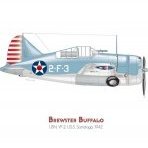
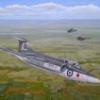
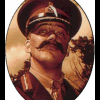


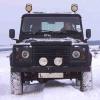
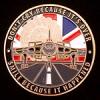



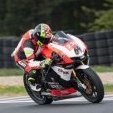

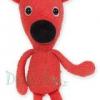
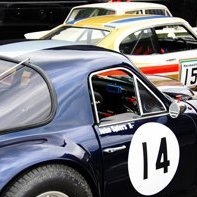
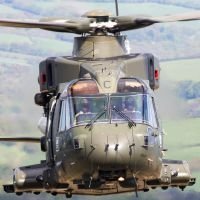

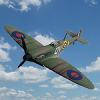



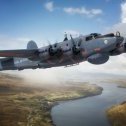

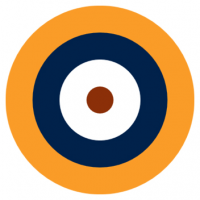
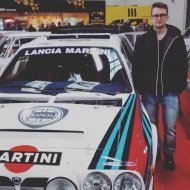
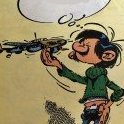

.thumb.jpg.ba34a9f6ddce411193946dbdcc7b5fe8.jpg)
